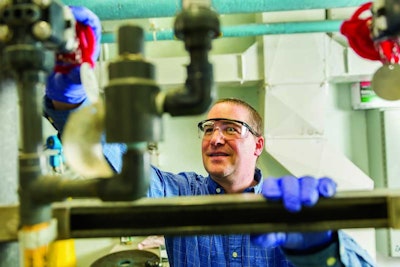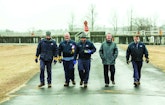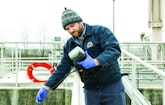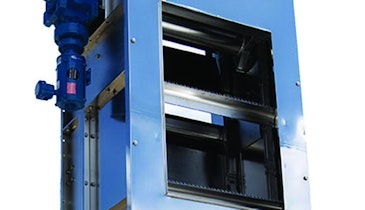
Interested in Pumps?
Get Pumps articles, news and videos right in your inbox! Sign up now.
Pumps + Get AlertsIt might be easy to miss the Penacook Wastewater Treatment Plant. It sits behind a farm, partially hidden in the Penacook Village area of Concord, New Hampshire. Yet, for the past 42 years, its operators have done exceptional work.
“Five years ago, this plant didn’t get the attention it deserved,” says Dan Driscoll, wastewater treatment plant superintendent. “The maintenance end wasn’t where it needed to be, so we doubled our efforts by painting the walls, cleaning and buffing the floors, upgrading the lights and improving the overall aesthetics. And someone noticed.”
That someone was Ken Kessler from the state Department of Environmental Services. “In 2014, Ken inspected the plant and reviewed all our compliance documentation,” recalls Driscoll.
The next year, the plant received the U.S. EPA Regional Wastewater Treatment Plant Excellence Award. Plant staff members were surprised, but shouldn’t have been.
Owned and operated by the City of Concord, the Penacook plant has had very few violations. “Our water goes out very clean,” says Driscoll. “TSS has been as low as 3 to 6 mg/L, and BOD as low as 7 to 9 mg/L.”
The operators have faced challenges that include a significant flow reduction, a switch to new technology, and issues with pH and inflow and infiltration (I&I). Their workload is heavy, as they also operate the city’s Hall Street Wastewater Treatment Plant.
New technology
The Penacook conventional activated sludge plant was built in 1973 to treat industrial discharge from the former Allied Leather Tannery. Says Driscoll, “We went through some of our historical reports, and it appears that the flow when the plant first went online was around 2.5 mgd. When the tannery reduced operations in 1979, the flow dropped to about 1.5 mgd.”
The tannery shut down in 1987 and the treatment plant flow decreased to 0.40 mgd, its current level. The plant serves 3,700 residents in Penacook and part of Boscawen.
The lower flow created problems. “The activated sludge stayed in the system longer, which caused unwanted bacterial growth,” says Driscoll. “The plant was still meeting permit, but the team members knew they needed to do a complete process overhaul.”
In 2005, the plant switched to sequencing batch reactor technology. The former primary clarifier and aeration tank are now storage basins for high flows that occur mostly in early spring.
The plant chose SBR technology for several reasons. “The operators were already familiar with the pumps and blowers used in the process, and it could be easily retrofitted into the old tankage,” says Driscoll. “It could also provide nutrient removal if needed in the future.”
Wastewater enters at a 25-foot-deep well, and is pumped through a mechanical step screen. From there, it enters one of two SBRs (Evoqua Water Technologies). Treated water flows into one of two equalization tanks, is disinfected with sodium hypochlorite, and is sent to chlorine contact tanks before discharging to the Merrimack River.
Liquid sludge is trucked to the Hall Street plant and combined with that plant’s sludge. It is then dewatered, turned into Class A biosolids in an alkaline stabilization process, and transferred to trailers. Resource Management of Holderness, New Hampshire, trucks the biosolids for use on farm fields or as a component of a manufactured topsoil product.
Upgraded plant
Besides the SBR systems, the 2005 Penacook plant upgrade included:
- Two Spiralift screw pumps (Evoqua)
- Three centrifugal pumps (Fairbanks Morse) for equalization tank pumping
- Chlorination system with three peristaltic tube pumps (Watson-Marlow)
- Three centrifugal aeration blowers (Continental Blower) for the SBRs
- Two submersible waste pumps and two motive pumps (all Flygt - a Xylem Brand) installed in the SBRs
- Two gravity thickener tanks retrofitted to aerated waste storage tanks, with a floating mixer (Evoqua) and three Delta blowers (Aerzen)
- New SCADA system (Rockwell Automation)
Startup went smoothly. “In the original plant, the flow ran from the primary clarifiers down a center channel between two separate aeration trains,” says Driscoll. “A series of gates fed off this channel, allowing the flow to be diverted to any or all of the four aeration basins. During construction, the two smaller front basins were isolated by closing the gates feeding them.
All flow was diverted to one of the larger back tanks, allowing the old treatment process to continue largely unaffected while work was completed on the SBR system.”
Evoqua representatives were on site for a little over a week to train operators on the SBRs. “Operators had no problem learning the SBR because it is so automated,” Driscoll says. “Also, sampling was very similar to the extended aeration process. The system has a proprietary program that allows us to easily adjust process parameters to achieve the best effluent quality.”
Sharing duties
A team of 15 takes care of the Penacook plant and the Hall Street facility, a 10 mgd (design) modified activated sludge/biofilter plant 10 miles away. Commissioned in 1981, Hall Street serves Concord and portions of neighboring Bow. The plant treats an average flow of 4 mgd along with 5 million gallons of landfill leachate and 2 million gallons of domestic septage per year. The plant generates 7,500 wet tons of Class A biosolids annually.
Four operators and the operations supervisor rotate duties Monday through Friday at the Penacook and Hall Street plants. One operator and one maintenance worker handle the Penacook plant. A dedicated technician does the majority of the laboratory work. The maintenance crew performs equipment troubleshooting and repair. Says Driscoll, “There are times, maybe once a month, when we send an additional operator to the Penacook plant for a day or two to help with a larger job or for safety reasons.”
Besides overseeing the operations supervisor position, Driscoll handles project work and regulatory tasks. “Since I got the superintendent’s job, I’ve had to buy a new chair because I’m in it more,” he says.
Removing the grit
Penacook plant operators see flows double or triple during storm events from I&I. “With the plant upgrade, the aeration tankage was retained and is used for storage during high flows,” says Driscoll. “Once flows return to normal, the stored wastewater is drained back to the plant’s headworks and processed through the system.” The city is addressing I&I by lining or replacing piping over the next five years.
During late summer and early fall, plant operators tackle low pH. “The flows are lower and we start nitrifying, which drives the pH down,” Driscoll says. “We manage that by adding more chlorine and reducing the air in the SBR as much as we can. We’ve never had a pH violation, but we have to keep an eye on it.”
Operators’ biggest challenge is cleaning the SBRs. “Every year, we remove one SBR from service for maintenance,” Driscoll says. “We drain the tanks, store the system solids and prepare the tank for cleaning, refilling and testing before placing it back online. This is very labor intensive and requires a methodical approach.”
Since the plant upgrade did not include a grit removal system, any grit that enters the plant accumulates in the SBRs. “After operating the systems for a few years, we decided to take the SBRs down one at a time, inspect the equipment and remove any accumulated grit,” Driscoll says. “When we inspected the first SBR, it was clear there was more grit than we expected.”
Operators shoveled the grit from the tank floor into wheelbarrows and transported it to the corner of the tank, then added water to create a slurry, which was removed with a city vacuum truck. It took six workers eight hours to complete the process for each tank.
To reduce labor, the operators tried using cribs (small dump containers on wheels). They used a rented crane to lower the cribs into the tank and then shovel the relatively dry grit into them. The crane then removed the full crib. With this method, the team can remove all grit from an SBR in an hour and a half with four workers.
“SBR downtime was reduced from almost three days to a little more than a day, which has significantly reduced issues with process solids storage and process issues when the SBR returns to service,” says Driscoll.
He considers it more cost-effective cleaning the tanks manually than constructing a grit removal system: “We have less equipment to maintain and we use less electricity. In the end, it’s about providing the best final product at the lowest cost with the least environmental impact; we feel this process does just that.”
Sustainable future
While Driscoll doesn’t foresee major upgrades at the Penacook plant, the Hall Street facility will be upgraded over the next 10 years. An engineering design is in process for three new secondary clarifiers to be built in 2017-2018. This year, the plant will receive a new screw pump, three new lift pumps and new sludge transfer pumps. A $1.8 million upgrade to the Class
A biosolids processing operation will include modifications to the odor control and ventilation systems.
Greater energy efficiency is a future goal. “In 2016, we will complete some lighting and controls projects to help conserve energy and reduce the plants’ carbon footprint,” says Driscoll.
In 2015, the city retained a consultant to study the long-term biosolids options. “Their recommendation is to construct a digester to reduce the biosolids mass and produce a Class A biosolid product without adding quicklime,” Driscoll says. “This would produce a more desirable product without the high pH. The city is seriously considering this option, although construction would be several years away.”
In the short term, Driscoll will be looking for new employees: “I have a fantastic crew, but many of them are retiring. In the next three years, I’ll lose half the staff. I’ve only had to hire one person in the last five years.”
The reason is simple: The city treats its people well. Says Driscoll: “If we need something, we can plan for it, and ultimately purchase technology and equipment that make our lives as pleasant as possible.”










